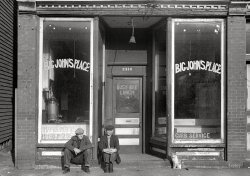
MAY CONTAIN NUTS

Search Shorpy
SHORPY ART

Framed or unframed, desk size to sofa size, printed by us in Arizona and Alabama since 2007. Explore now.
Join and Share
Ad-Free Shorpy
Shorpy is funded by you. Patreon contributors get an ad-free experience.
Learn more.

Recent comments
- Baldwin 62303
- Baldwin VO-1000
- Cold
- No expense spared
- Tough Guys
- Lost in Toyland
- And without gloves
- If I were a blindfolded time traveler
- Smoke Consumer Also Cooks
- Oh that stove!
- Possibly still there?
- What?!?
- $100 Reward
- Freeze Frame
- Texas Flyer wanted
- Just a Year Too Soon
- WWII -- Replacing men with women at the railroad crossing.
- Yes, Icing
- You kids drive me nuts!
- NOT An Easy Job
- I wonder
- Just add window boxes
- Icing Platform?
- Indiana Harbor Belt abides
- Freezing haze
- Corrections (for those who care)
- C&NW at Nelson
- Fallen Flags
- A dangerous job made worse
- Water Stop
Member Photos
The Shorpy
Print Emporium
Print Emporium
Search Shorpy
Search results -- 30 results per page
- White Wash: 1951
- ... Which extended, evidently, even to pillowcases. Photo by John Vachon for the Look magazine article "How Far From Slavery?" Who'll be the ... Posted by Dave - 08/09/2013 - 8:40am -
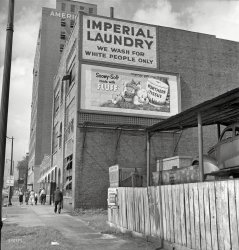
- Baked a Cake: 1940
- ... Greene County, Iowa." Medium format acetate negative by John Vachon for the Farm Security Administration. View full size.
Drip, ... Posted by Dave - 11/12/2020 - 10:21am -
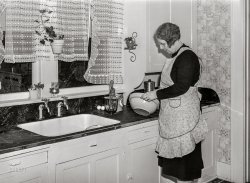
- Pull In for Pepsi: 1941
- ... Norfolk, Virginia." Medium format acetate negative by John Vachon for the Farm Security Administration. View full size.
Breakfast, ... Posted by Dave - 06/24/2020 - 12:18pm -
![Pull In for Pepsi: 1941 March 1941. "Four o'clock traffic. Norfolk, Virginia." Medium format acetate negative by John Vachon for the Farm Security Administration. View full size.
Breakfast,Dinner, Supper, that's what we called them, now everyone calls "supper" dinner.
[And "dinner" is lunch. - Dave]
Old Tiny LibraryThere are other words -- in cursive -- on the sign, but I can't make them out, so I'll just say I want to visit the Old Tiny Library and buy a few gifts, then go to the cafe for dinner (lunch) of a sandwich, with what my stepdad used to call a "Coke-Cola."
Granby StreetAfter reviewing this photo for a while, and taking into account this is afternoon traffic, I have to think that this is a photo of Granby Street just south of where it crosses the Lafayette River. The cars are probably returning from shifts at the Norfolk Naval Yard I am wagering.
Almost too Tiny to tell, butDoes the sign maybe say "Old Timy" library? More commonly spelled "timey" these days?
[Yes! - Dave]
Spell bindingThanks to Kines and Dave on the spelling of Old Timy -- as opposed to Tiny. To be honest I thought I saw an M as opposed to an N but the word "Timy" would not register. Guess I'm a traditionalist.
You CAN have it both waysOne establishment serving both Coke and Pepsi? This is truly a bygone era.
(The Gallery, Cars, Trucks, Buses, Eateries & Bars, John Vachon)](https://www.shorpy.com/files/images/SHORPY-8c18962a.thumbnail.jpg)
- Kewpee Hamburgs: 1940
- ... last glimpsed here ). Medium format acetate negative by John Vachon. View full size.
Nice House I realize the focus is on the ... Posted by Dave - 12/04/2019 - 3:14pm -
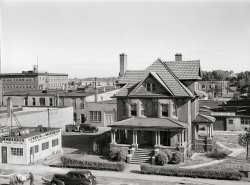
- F.W. Woolworth: 1940
- ... Company, Indianapolis, Indiana." 35mm nitrate negative by John Vachon for the Farm Security Administration. View full size.
I grew up ... Posted by Dave - 02/18/2012 - 3:00pm -
![F.W. Woolworth: 1940 May 1940. "Woolworth Company, Indianapolis, Indiana." 35mm nitrate negative by John Vachon for the Farm Security Administration. View full size.
I grew up on the far I grew up on the far eastside of Indpls and remember the day the Grant building was on fire. I came home from school and it was all over the news, I was young and got the impression the whole downtown was on fire.
CrispThe Woolworth facade is like the crisp dollar bill you find in the middle of the worn and well circulated dollar bills in your wallet.
ConflagrationThe left-most structure was the Thomas Building. It and the Grant building adjacent to it were consumed by a massive fire in November 1973. In all, 15 buildings were either destroyed or damaged.
http://digitallibrary.imcpl.org/ffm/ffmGrant.php
By this time the Woolworth building had become the Kirk Furniture building. Today it houses a Buffalo Wild Wings. The brick building to its right was then called the MNB building and still stands.
This photo shows the backside of the Grant buiding as the fire raged:
Calling Dr. FreudNow there is a building with an inferiority complex!
A Rose Between Two ThornsI don't know what style of architecture that is, but I sure do like it! Those sleek lines and shiny facade just make you want to go in and shop for some moth balls and shaving cream, then wind up at the lunch counter for a burger!
[This is Art Deco style. - tterrace]
Thanks! I thought it was. It looks like what the future should have been!
Still there today!This beautiful Art Deco building is still standing, as is the one to the right of it. I was admiring the Shorpy version of the building and, when I saw on Street View it is now Buffalo Wild Wings, realized I've been inside it!
(The Gallery, Indianapolis, John Vachon, Stores & Markets)](https://www.shorpy.com/files/images/SHORPY_8a06297a.thumbnail.jpg)
- Lincoln: 1942
- ... 1942. View full size. 35mm Kodachrome transparency by John Vachon. Farm Security Administration/Office of War Information.
Turn around ... Posted by Dave - 03/17/2011 - 9:44am -
![Lincoln: 1942 Lincoln, Nebraska. 1942. View full size. 35mm Kodachrome transparency by John Vachon. Farm Security Administration/Office of War Information.
Turn aroundThis shot makes you wonder what the girl looked like
Where Did Everybody Go?Except for the one young lady, the streets are deserted! It's interesting that the cars are all shades of blue, black, white or gray, which isn't all that much different from what the color of cars have been for the last twenty years as well. I miss the way they looked in the early 70s, which was the only era in which autos came in all sorts of loud primary and secondary colors.
Lincoln : 1942The streets are lonely ; but the number of cars are no way, less ! Are they Austin cars ? (Austin of England) Or might be Morris.
[These are all American cars. - Dave]
Re: VehiclesI think the second car from the right is a 1940 Chevrolet, not 1941.
More than the girlYou can see 2 guys to the right of the girl, toward the 1st corner a guy with a blue shirt and hat is walking toward the parked cars, if you go to the right of him another guy looking down with a brown hat. Also at the next intersection it looks like a group of people are getting ready to cross the street
VehiclesIt appears to me to be, from the left, a light-colored '41 Ford, then '41 Chrysler, '41 Chevrolet, '38 Buick, '41 Chevrolet, '39 Ford.
For Idleracer, yo're right; cars have become more bland. The high spot was the mid '50s, when they even had tri-tone. (I had a '55 Roadmaster with orange-red top, light gray midsection and orange-red under the sweepspear . . )
VehiclesI think you're right, Dave. The photo was dark enough I didn't notice the separate parking lights, and did not recall the chrome stripe atop the headlight housing on my late uncle's '40 model . . .
View is 13th South of N St. looking NorthI'll have to send you a picture of this scene today...probably one of the few places in Downtown Lincoln that look exactly the same. I couldn't figure out the location of the other picture posted of Lincoln..I think all the buildings in it have been razed.
Cars are from all overThe first plate in the front is a beautiful 42 Kansas Sunflower plate from Brown County. The next behind is from Lincoln, Nebraska. I can only see a corner of the next one, but it looks like Hastings, Nebraska (14). The next plate up the street is Sedgwick County, Kansas. The last car up the street looks surprisingly like a 41 California plate, but I can't make it out well enough.
Considering an A ration in 1942 was 3 gallons a week, they must have saved up their gas to all get into Lincoln?
[There was no rationing yet in the Midwest. (Which why none of the cars have ration stickers on the windshields.) On May 15, 1942, gasoline rationing began in 17 Eastern states. The allotment was three gallons a week. It wasn't until December 2, 1942, that gasoline rationing was required in all states. - Dave]
Gas RationingThanks. I'd forgotten that rationing didn't cover the non-Eastern states until almost 1943.
My granedfather didn't have an A ration. He had a nearly unlimited ration. He was a vital war worker, working in the Southern Illinois oil fields. And a horse ate his soybean 1943 license plate. He backed the car up to the fence by the horse field and the horse ambled over and took a big bite out of it. He had to get a replacement.
ChryslerThat's a '42 Chrysler. The '41 had a taller grille.
+68As noted previously, this is 13th Street looking north from N Street. The girl and flags are gone and the curbs have been modified, but otherwise, the scene is virtually the same. I've attached a shot of the same perspective taken on March 22, 2010.
(The Gallery, Cars, Trucks, Buses, John Vachon, Patriotic)](https://www.shorpy.com/files/images/1a34271u.thumbnail.jpg)
- Best Domestic Coal: 1938
- ... Omaha, Nebraska." Medium format acetate negative by John Vachon for the Farm Security Administration. View full size.
Staying ... Posted by Dave - 08/09/2020 - 8:41pm -
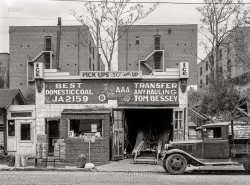
- Earth Colony: 1942
- ... Borger, Texas. Storage tanks." Medium-format negative by John Vachon, Office of War Information. View full size.
White Heat "Here ... Posted by Dave - 08/01/2012 - 1:35pm -
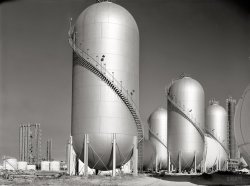
- A Bumper Crop: 1938
- ... and family. Guilford County." Medium format negative by John Vachon for the Farm Security Administration. View full size.
Fashion ... Posted by Dave - 11/24/2017 - 1:53pm -
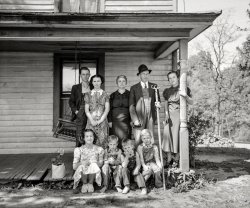
- Window-Dressing: 1941
- ... the interpretation up to you. 35mm nitrate negative by John Vachon. View full size.
Outrage! Surely (stop calling me Shirley!) ... Posted by Dave - 02/18/2013 - 1:45pm -
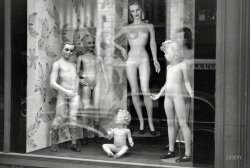
- Uprooted: 1940
- ... the lady seen here last week. 35mm nitrate negative by John Vachon. View full size.
Imagine Just think of the uproar if we tried ... Posted by Dave - 05/24/2011 - 4:50pm -
![Uprooted: 1940 July 1940. Berrien County, Michigan. "Migrant mother of family from Arkansas in roadside camp of cherry pickers." Our second look at the lady seen here last week. 35mm nitrate negative by John Vachon. View full size.
ImagineJust think of the uproar if we tried this with the unemployed youth of today, the very idea of work would scare them shitless and the ACLU would have their underwear in knots screaming "abuse." These boys liked a hard day's work and they looked it, bet they walked standing tall not slouched and shuffling, true young men, boys are like horses if not worked hard when they are young they are never much use when mature, need to be pushed all the time.
[Back during the Depression, my granddad had to wear the same dress two whole years. - Dave]
Hard timesNot an iPhone or iPod in sight, folks think they have it hard today.
WowLindsy Lohan has really hit the skids!
Truer Image (IMO)This picture emphasizes the nomadic lifestyle, lack of creature comforts and the stress of being a migrant worker then. In the previous picture she appeared almost as a harried soccer Mom. Here fatigue is evident in her face.
Note the broken mirror propped in front of the washing basin in front of the rear fender.
And someone should tell her that her slip is beginning to show.
Indescribably sadThis picture makes my heart ache just looking at it. Even the majority of 'poor' people in this country (the US) have it good in this day and age compared to poor people then. Today (and hopefully beyond) I'll make a conscious effort to appreciate the most simple things we take for granted. A shower, a refrigerator, air conditioning, a comfortable bed, the list is endless.
The face of sheer hopelessnessI was thinking along precisely the lines of SlamDance when I saw this picture. It isn't only this one; there are numerous others on this site which depict people in similar situations. Most of these people don't just look tired; I imagine they had always been used to simple hardship, and hard work; here, one can see the utter dejection, the misery, and the hopelessness in their faces. It is awful to imagine just how hopeless they must have felt. I imagine that a reasonable number of them had been, some time previously, whilst not in any way wealthy, at least able to have shelter and to be able to get their daily bread.
That woman's privations are now almost certainly over. Maybe her children, if she had some, still remember her tears when she could maybe not provide food some days. Of course, there are teeming millions around the world in just such a situation today.
My apologies for being mawkish; but, gosh, what images these pictures conjure up ....
David
Leicestershire, England
Luck?As I sit here eating my morning oatmeal and seeing this photo, I'm thinking....How lucky I am!!
Picture does me goodI needed to see it this morning. Sometimes you forget all you have to be happy about. Poor lady, I hope she had some happy times.
Modern migrantsI think that some of the people who make comments about how people today don't know how to work should go visit a migrant workers' camp today. Sure they have more than they did in this picture, but their living conditions are not significantly better. Our country is lucky that we don't have a large portion of a population that lives so poorly, but it doesn't mean that this still doesn't occur; only the demographic of the migrant has changed.
Cute edit DaveMy comment was meant for the post "Boys to Men," smartypants.
I suggest you tell those boys that they were skirts.
[Were? Wear? - Dave]
Previous commentsThe two odd comments above are obviously referring to the "Boys to Men" image right behind this one. Odd glitch in posting, I guess.
Mommaappears to be pregnant. No wonder she's exhausted.
Why I like it hereThis is a great group here, with a rare talent; the ability to look at a black-and-white image from long ago, and care about the people in it.
And yet --She has an automobile, a rather considerable capital asset that lets her and her family go in search of work. The muscles on her bare arms and legs are well-fleshed, and she doesn't show the signs of chronic malnutrition. I can see a number of cooking and serving vessels, large and small, and a couple of pieces of simple furniture. She's poor, yes, but by the standards of an African villager or a Brazilian favelista, who would regard the chipped enamel cooking pot as wealth to be proud of, she's incredibly well off.
Mawkishness isn't to be avoided. We should always have sympathy for those less fortunate, but we should also be alert to attempts to manipulate that sympathy. What this woman and her family need is a busy productive economy, which they can contribute to and earn their share. All too often we've allowed the cynical to use "abject poverty" as an excuse for redistributionism, which feathers their nests rather comfortably from the reasonable expenses they take out in the process but makes the problem worse by crippling the overall economy.
Picture brings back memoriesThat woman closely resembles my mother in 1940. When I was 5 years old, my mother, my sister, and I were living in a converted chicken coop on my uncle's farm in Oklahoma, while my father was looking for work in Kansas. Many a day our only food was beans and bread. I appreciate the compassion shown by many posters on this site for the plight of common folk at this time in American history. Gotta say, WWII saved the economy of this country.
(The Gallery, Great Depression, John Vachon)](https://www.shorpy.com/files/images/8a06866a.thumbnail.jpg)
- Rear Entrance: 1937
- ... for this curious scene. Medium-format negative by John Vachon. View full size.
You Are Here This might be about where ... Posted by Dave - 02/14/2013 - 12:06pm -
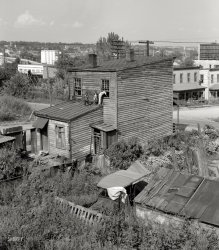
- Municipal Elevator: 1940
- ... section of bluffs." Medium format acetate negative by John Vachon. View full size.
Carbon-Arc Lamp By 1940, this was an ... Posted by Dave - 12/10/2019 - 1:29pm -
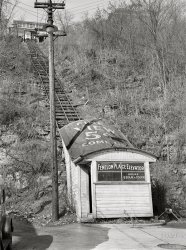
- Tire, Iron: 1942
- ... that include the car?) Medium format acetate negative by John Vachon for the Farm Security Administration. View full size.
... Posted by Dave - 02/21/2022 - 1:54pm -
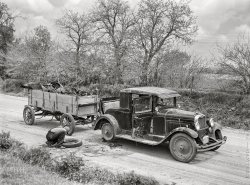
- Truck Stop: 1943
- ... in New York, the venue of the previous post, also shot by John Vachon for the OWI. View full size.
Still standing The Hecht Company ... Posted by Dave - 01/27/2013 - 1:18pm -
![Truck Stop: 1943 March 1943. "Transport refueling at Hecht Co. warehouse on New York Avenue in Washington, D.C." As opposed to Washington Street in New York, the venue of the previous post, also shot by John Vachon for the OWI. View full size.
Still standingThe Hecht Company Warehouse is on the U.S. National Register of Historic Places.
View Larger Map
My My still the sameMy sister worked here for awhile. I worked around the corner for awhile. Fascinated by the IBM building shot. Always wondered what it used to be.
Weigh-inLooks like the truck is also sitting on a scale.
And across the streetmore or less: a building where IBM manufactured almost all of its punch cards. (If you don't know what a punch card is, sigh )
Art Deco Masterpiece!Although the Hecht Company was taken over by Macy's, the warehouse is still there, at 1401 New York Avenue, N.E. in Washington. It isn't used by Macy's but it is on the National Register of Historic Places for its architectural merit as a art deco masterpiece.
Big Truck, Little MirrorDang that is a beat to heck truck getting weighed. It is missing grille bars and those fenders look like they have been pounded out more than once. But what is most amazing is I only see two mirrors. The passenger side one appears to be for him to see the top of his trailer. It is impossible that it sees anyone driving along its passenger side
[The mirrors appear to be a matched set, hinged and telescoping, with the one on the passenger side raised for the truck to pull up to the pumps. - tterrace]
Mack MB at the scale houseYes that is a scale I drove across a lot of them over the years. That is a Mack MB tractor from around the mid 30's it has the two piece windshield.
Planeless but not TrainlessThose look like boxcars off on the right. Railyard?
Truckis a '36 GMC.
A local landmarkfor local traffic reporters ("New York Avenue backed up to the Hecht Warehouse", Lisa was heard to say).
Trains@perpster - You are correct. Not precisely a yard, but a set of multiple tracks with sidings leading up to the yards near New York and Florida Avenues, a bit west of the warehouse.
Mirror on MackThe mirror pointing up is to see the roof of the box so when you go under an overpass you can see if you're going to scrape it. Back in those days bridges and tunnels were not always marked, and if they were when the road was paved the clearance was not always changed. New parts were hard to get in 1943.
(The Gallery, Cars, Trucks, Buses, D.C., Gas Stations, John Vachon)](https://www.shorpy.com/files/images/SHORPY_8d26867a.thumbnail.jpg)
- Cheersh: 1941
- ... Crossing, Michigan." Medium format acetate negative by John Vachon. View full size.
Bottle Can Glass To me it always seemed that ... Posted by Dave - 02/29/2020 - 5:46pm -
![Cheersh: 1941 August 1941. "Farm boys in beer parlor on Sunday afternoon. Finnish community of Bruce Crossing, Michigan." Medium format acetate negative by John Vachon. View full size.
Bottle Can GlassTo me it always seemed that pouring from a bottle or can into a glass allowed the brew to breathe a little, thus taming the carbonation and improving taste. After the third one though, who cares.
Royal Bohemian BeerLooks like they are enjoying Royal Bohemian from the Duluth Brewing & Malting Company.
Sisu, eh?All communities thereabouts are Finnish communities. Pritnear every Yooper is at least part Finn.
GlassesFind out that they use glasses to drink beer. I'm not American and I find that in every American film people drink beer directly from bottles. Is it now normal as it was normal to use glasses in forties?
[In my experience, most bottle beer in restaurants and bars here in America is poured into glasses or mugs. - Dave]
Natty BohThe boys are enjoying some National Bohemian Pilsner. A bit surprising, since Bruce Crossing is in the UP, and Natty Boh was brewed in Baltimore. I would have thought Milwaukee or Detroit suds would have been the beer of choice.
[The beer is Minnesotan -- Royal Bohemian from Duluth. - Dave]
(The Gallery, Eateries & Bars, John Vachon)](https://www.shorpy.com/files/images/SHORPY-8c19965a.thumbnail.jpg)
- A Chat With Marilyn: 1953
- ... while in Canada to film River of No Return . Photo by John Vachon for Look magazine. View full size.
Candid She never took a ... Posted by Dave - 07/18/2013 - 7:22pm -
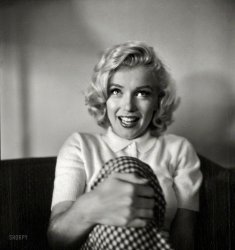
- Dubuque: 1940
- ... seen in background." View full size. 35mm negative by John Vachon.
Dubuque is a Mississippi River Town. Dubuque was one of the ... Posted by Dave - 01/27/2008 - 12:00am -
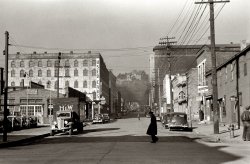
- Northern Swing: 1938
- ... for Negro families. Omaha, Nebraska." Acetate negative by John Vachon. View full size.
Focus on shoes The still center of all the ... Posted by Dave - 08/07/2020 - 7:04pm -
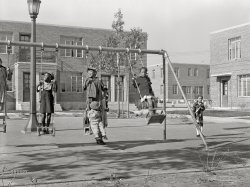
- Maryland Crab House: 1938
- ... and clams to go, please. Medium-format nitrate negative by John Vachon. View full size.
"Negro section" According to the ... Posted by Dave - 02/21/2013 - 11:43am -
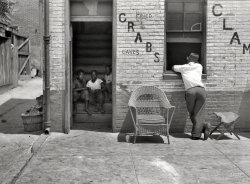
- Gasolene Gospel: 1937
- ... as well as two verses from the New Testament. Photo by John Vachon. View full size.
Intersection today The warehouse across the ... Posted by Dave - 02/13/2013 - 3:54pm -
![Gasolene Gospel: 1937 August 1937. "Gas station and gospel mission in Cleveland, Ohio." In addition to Koolmotor "Gasolene," a long-defunct Cities Service brand, we also seem to have at least a couple of the major food groups represented here, as well as two verses from the New Testament. Photo by John Vachon. View full size.
Intersection todayThe warehouse across the street is still standing, though the facade has been updated. Otherwise the intersection is quite different.
View Larger Map
Missing Billboard"Pray And Get Gas"
English Teacher's NightmareGasolene. Kool. Thru. Towards. No wonder the kids today can't spell.
Hotel Auditorium Wonderful photograph!
From the web site, Cleveland Memory, regarding the Hotel Auditorium: The Hotel Auditorium is Cleveland's newest hotel in the downtown section, and is directly across from the famous Cleveland Public Auditorium.
It was located at East 6th Street and St. Clair Avenue and apparently opened in 1930. Wonder what the difference was between a two dollar and a two dollar and a half room.
[If the Hotel Auditorium had an auditorium, things could get super confusing. - Dave]
Way Kool!!!This photo is just begging for colorizing! What a scene!
And I want that panel truck!
But does that second Bible verse read oddly to anyone else? I was expecting it to be "those" instead of "them." I suppose that's the King James Version of the text, which usually sounds so wonderful to my ear.
Amazing Photo!Again, Shorpy whisks us away to another time and place. In a flash, it's 1937. Thanks Shorpy!
All Closed CarsWhat I love about these pics are the old cars in their natural surroundings. Gather a group of cars of this era today and there will be a preponderance of open cars. Twenty-one cars in this pic and not a one of them an open car!
Three times three slices of bread.Why not an even number, so you don't wind up stuck with half a sandwich.
My CliffordvilleYes, I think I have found it. But with a happier ending, please.
Terminal TowerPeeking over the building in the upper left corner.
Bible verseIn response to Jim Page's comment, the verse sounds odd now, but remember that several of today's most popular Bible translations hadn't even been written in 1937.
On a different note, I can't be the only one here who wouldn't mind paying a visit to the ice cream truck on the bottom left.
Well Ethylis standing right next to the Koolmotor gas pump. Looks like their glass globes are canted toward each other and they're carrying on a conversation. Koolmotor is asking, "Is your name really Ethyl?"
I love old gas stations.
Looks like all the "night parking" is filled up and it's only 5 minutes to 3.
Wheels "O" RollinYou've got to love those old trucks.
The AuditoriumI presume the Auditorium Hotel received that name because it was located across the street from the Public Auditorium, which is part of downtown Cleveland's Group Plan designed by Daniel Burnham. The Auditorium Hotel is gone, but the site had another hotel, which is now getting a major re-work in anticipation of the reopening later this year of the downtown convention center after its own major overhaul. A corner of Public Auditorium can be seen in the upper right corner, showing the word "CONCEIVED" as part of the sentence inscribed on the building.
[“A Monument Conceived as a Tribute to the Ideals of Cleveland, Builded by Her Citizens and Dedicated to Social Progress, Industrial Achievement and Civic Interests” - tterrace]
The March of Time Will Now Take a Short BreakLiving for a while some 164 blocks East of this scene and nine years later, I found similar cars to be common sights during my daily wanderings. The three-year hiatus in passenger car production during WWII, coupled with delays in getting Detroit reconfigured after war production, meant that many cars of the '30s soldiered on for some time after peace broke out. I recall finding cars with "lights that stick out" preferable to more modern ones ... and I suspect that I still do.
Pack 'em inI like the painted lines on the walls for spacing the night parking.
Shorpy TruckShorpy truck on the left. Filled with large format glass negatives, waiting for the internet.
That lounge chairThat lounge chair intrigues me. What an odd position to put a chair like that. I realise the angle and camera standing adds to the visual illusion, but to me, it remains strange placement.
St. Clair and E. 9th Street in 1963Here is a photo from the Cleveland Public Library Digital Gallery. It shows a view of this block from the St. Claire Avenue side. The City Mission is still there, and the Koolmotor station is a Sohio in 1963, but a lot of the rest of the view ended up as parking lots for a while.
(The Gallery, Cars, Trucks, Buses, Cleveland, Gas Stations, John Vachon)](https://www.shorpy.com/files/images/SHORPY_8b31481a.thumbnail.jpg)
- Live Better Electrically: 1938
- ... near the Nebraska Power Company plant, Omaha." Photo by John Vachon for the Resettlement Administration. View full size.
Where has ... Posted by Dave - 08/02/2017 - 9:21am -
![Live Better Electrically: 1938 November 1938. "Houses near the Nebraska Power Company plant, Omaha." Photo by John Vachon for the Resettlement Administration. View full size.
Where has the mortar goneOn the chimneys of the house on the right?
[Victim of acid rain. -tterrace]
CapitalsGood bet that they're wood. The first house I owned was built in 1894 and had columns just like those. The gingerbread was ALL wood.
From Powerhouse to PunNebraska Power Co. was the last privately-owned utility in the state, and was acquired by the Omaha Public Power District in 1945, seven years after this photo was taken. Located near the Missouri River and at the corner of Fourth and Leavenworth in Omaha, the power plant has been converted to a residential complex know as The Breakers, as in circuit breakers.
Little HouseLove the little birdhouse. So much to see here!
Wood or cast iron?Those column capitals really beat me.
What I can't make out, are they wood, or cast iron? Cast iron gothic (or classicism) was quite popular for a while, probably along with carpenter gothic (or classicism).
Photographer EntourageA watchdog has eyes on them.
Before "clean" coal??Too bad these residents lived so close to that coal fire power plant that spewed out plumes of pollution. Today they would be promised "clean" coal and enjoy much healthier lives. (If clean coal exists).
Also shown hereHouses also shown in this photo.
(The Gallery, Industry & Public Works, John Vachon, Omaha)](https://www.shorpy.com/files/images/SHORPY-8b37420a.thumbnail.jpg)
- Gobblers: 1940
- ... Happy Thanksgiving from Shorpy! 35mm nitrate negative by John Vachon for the FSA. View full size.
Gotta go tell the king Turkey ... Posted by Dave - 11/24/2011 - 3:24pm -
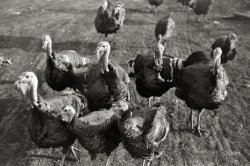
- Keep a Light On: 1940
- ... Pierre, South Dakota." Medium format acetate negative by John Vachon for the Farm Security Administration. View full size.
Truck ID ... Posted by Dave - 01/03/2020 - 7:54pm -
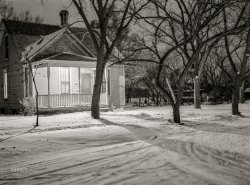
- The Omaha Kid: 1938
- ... Street, Omaha, Nebraska." 35mm nitrate negative by John Vachon for the Farm Security Administration. View full size.
Wondering. ... Posted by Dave - 08/02/2017 - 9:23am -
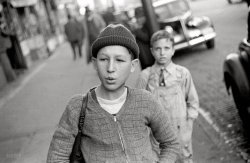
- Max: 1940
- ... Dakota. Population 500." Medium format acetate negative by John Vachon for the Farm Security Administration. View full size.
Max, North ... Posted by Dave - 12/31/2019 - 1:47pm -
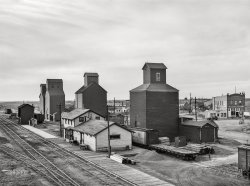
- Shooting the Breeze: 1938
- ... Georgia. View full size. 35mm nitrate negative by John Vachon for the Farm Security Administration. We met two of these characters in ... Posted by Dave - 01/24/2008 - 7:00am -
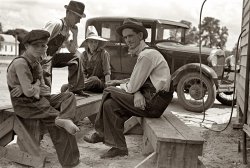
- Overture to Death: 1943
- ... "Photo Lab Index."
[Here she is in a 1944 photo by John Vachon. -tterrace]
Ah, the irony It might not have been a bad idea for ... Posted by Dave - 12/13/2013 - 2:35pm -
![Overture to Death: 1943 October 1943. Washington, D.C. "Servicemen and girl at a party." Our title comes from the bookshelf, although it could be from the girl. Strategically, her companion has the right idea: Get your lady comfortable with food and drink, and maybe a pillow. Add conversation and stir. Operationally, though, we'd say the execution needs work. Photo by Esther Bubley, Office of War Information. View full size.
Alternate TitleGoodbye, Mr. Chips.
I wonder if Dr. Seussever regretted doing the illustrations for 'The Pocket Book of Boners'?
No Fun Here!There is no ashtray for the long-ashed cigarette; the glasses appear empty (at least to me); the girl appears bored; the guy appears desperate.
Doesn't look like anyone is having a good time, except his buddy, who seems to be laughing at the whole thing.
Anotherpotential title: Farewell, My Lovely. He looks like he's about to slide down and disappear. And his buddy looks ready to be more then happy to take his place.
Alternate Alternate TitleThe Pocket Book of ... no, that's too easy.
Another possible title"Pocket Book of Boners" might have been more appropriate.
Too Gauche?"The Pocket Book of Boners."
Doubt you'll post this but --I'd have gone with "The Pocket Book of Boners."
I SpyMy copy of 'Victory Through Air Power'. Interesting book. I've always wondered where it had come from.
Headhunting In The Solomon IslandsCaroline Mytinger and her pal Margaret Warner on their own in the prewar Solomons looking for heads they could paint!
I have that book and those two ladies were simply amazing. A very nice bookshelf IMO.
Old HatOn top of the bookcase are 2 U.S. Army WW2 enlisted men's Class A Uniform Visor Caps. The badges are upside down and too blurry for me to make out. Attached is the American Eagle emblem usually worn on this headgear. The Officer's cap had a larger image not encircled.
Pall MallLong time since I have seen a pack of Pall Mall. About 1946 [ my Aunt].
Successful jump from shelf to screenThe best book on that shelf is "A Coffin for Dimitrios" by Eric Ambler. It's about a reporter traveling Europe between the world wars who crosses the path of an international master criminal. Picked up at a yard sale in the early 1970s, it is one of the best books I've ever read for mystery, espionage and treachery. I pictured Peter Lorre and Sidney Greenstreet as characters. Low and behold in the 1980's, while walking by a little theater of Drexel University in Phila, the next movie to be watched and discussed was "The Mask of Dimitrios" Yes it was, and starring the actors I had imagined. The movie was oh so good!
Disney's "Victory Through Air Power"Disney used the shown book "Victory Through Air Power" as a basis for a highly successful 1943 propaganda film of the same name.
The Pocket Book of BonersWhen I was eleven years old, looking for entertainment at a cabin on an island in the north woods, I discovered that book. It kept me laughing for days.
In those old days, the word "boner" was slang for a mistake. Here's one that was hysterically funny for me at age eleven: From a classroom quiz, one student's answer to the question of the conquest of Mexico was, "Mexico was conquered by Kotex."
Was This Esther's Bubley's Apartment?On the bottom shelf is a copy of The Photolab Index which was a compendium of all kinds of technical photographic information. It would have been owned by a serious photographer who needed ready access to data from all the then current manufacturers, as well as articles on chemistry, optics, etc.
Pall MallsMy mother used to smoke these and when I was much younger I used to swipe a few and go up in the attic to smoke!
The next day he said with a wink:"Guys, I tell you, I just met her last night and in no time I had her head on a pillow, if you know what I mean!"
Selfie?The woman in the photo bears a striking resemblance to . . . Esther Bubley. I note that only one of her hands is visible, and that one of the books on the lower shelf is the photo-geek bible, "Photo Lab Index."
[Here she is in a 1944 photo by John Vachon. -tterrace]
Ah, the ironyIt might not have been a bad idea for the serviceman to have perused Headhunting in the Solomon Islands, as it's not impossible that he ended up there. The islands were the site of some heavy fighting which continued to the very end of the war, even if the worst was over by the photo's date.
While most of the titles have long since faded into obscurity, two that stand out are Cross Creek, the memoirs of Yearling author Marjorie Kinnan Rawlings, and of course Pygmalion. Sapphira and the Slave Girl by Willa Cather is an example of a rather obscure book (her last, in fact) by a famous author. As for A Coffin for Dimitrios, I fully agree with an earlier comment that Eric Ambler was an excellent writer.
Still, the most thought-provoking title by far is Siamese Twin Mystery. What happens if one of them is a murderer? You can't throw him in prison without punishing the other, innocent one, so what do you do?
BookshelfWhen one looks up some of the titles on that bookshelf, some should still be readable (Eric Ambler, for instance).
Although almost all seem to be out of print by now. However, some are called out with an astonishing price tag on the used book platforms.
Book IdentificationThe large volume on the lower shelf is "Currier & Ives Printmakers to the American People" by Harry T. Peters.
Literary tastesI respect the reader's choice of Willa Cather's "Sapphira and the Slave Girl"; probably the foremost novelist on those shelves.
Two Familiar Items My mother's unfiltered Pall Malls. I might have snuck one or two. They were pretty rough but what I most remember is studying the heraldic looking thing on the front of the pack when I was mid single digits.
My copy of Victory Through Air Power is not much worse for wear than the one here and dated 1942. The jacket is a dark or navy blue toward the top of the jacket fading to a lighter blue with gray clouds at the bottom.
Overture to Deathis still in print, and I have a copy too. It's a pretty funny book about two spinsters vying to be the top dog in an English village. It's by Ngaio Marsh.
The Man Who Murdered HimselfBy Geoffrey Homes, published by William Morrow in 1936, and by Avon as a paperback in 1942. Competition for Siamese Twin Mystery in Peter's most-thought-provoking-title category.
Nero and AgathaLots of good Nero Wolfe titles on that shelf, and Agatha Christie too. Nice to see some of the classics.
Above SuspicionThree books to the left of Eric Ambler's superb A Coffin For Demetrios (top row of paperbacks) is another book to check out.
Above Suspicion (1941) was the first book by Helen MacInnes. It tells a terrific pursuit and escape story of a newlywed British couple who are asked by a friend in intelligence to go to Germany on their honeymoon and pass a few messages to certain people in certain cities. They were picked for the job because they'd be "above suspicion."
The time, I think, is summer 1938. The tenseness of the period is very well handled, and you'll get a thoroughly convincing feel for the quiet menace behind everyday German life.
Those books! Those books are collectible the ones with the keyhole on the spine are "Map Backs",mystery books with maps printed on the back of the book,to illustrate where the story takes place. Early writers on that genre got a start there.
Thanks for recommendationChecked out a collection of four Eric Ambler stories contained in one book titled "Intrigue" from the local library. Just finished reading "A Coffin for Dimitrios" and found it superb.
I was initially surprised that the book was still available for checkout especially since it was first placed into circulation back in 1965 according to the checkout card still located inside the back cover of the book. It also indicates that the book was checked out 36 times between November 4, 1965 through October 27,1986. It then sat for almost six years before being taken out again. The last entry appears in '94 after which the book was likely moved to electronic record keeping. It appears that the book still gets out enough in circulation to warrant keeping it around...
(The Gallery, D.C., Esther Bubley, WW2)](https://www.shorpy.com/files/images/SHORPY_8d33892u.thumbnail.jpg)
- A Solo Stroll: 1941
- ... in Ontonagon County." Medium format acetate negative by John Vachon for the Farm Security Administration. View full size.
Anytown ... Posted by Dave - 03/20/2020 - 5:03pm -
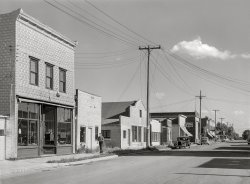
- Curb Service: 1937
- ... mouse sandwich, coming right up. 35mm nitrate negative by John Vachon for the Farm Security Administration. View full size.
Curb ... Posted by Dave - 07/13/2012 - 2:57pm -
